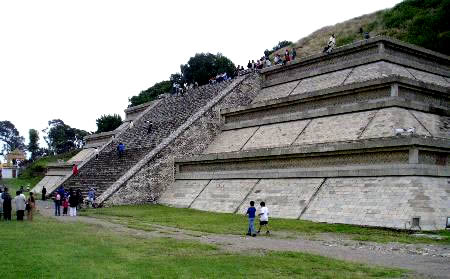Puebla & Cholula Tour Prices & Bookings
Featured Cholula Tour
The Great Pyramid of Cholula, also known as Tlachihualtepetl (Nahuatl for “artificial mountain”), is a huge complex located in Cholula, Puebla, Mexico.
It is the largest archaeological site of a pyramid (temple) in the New World. The pyramid stands 55 metres (180 ft) above the surrounding plain, and in its final form it measured 400 by 400 metres (1,300 by 1,300 ft).

The pyramid is a temple that has traditionally been viewed as having been dedicated to the god Quetzalcoatl. The architectural style of the building was closely linked to that of Teotihuacan in the Valley of Mexico, although influence from the Gulf Coast is also evident, especially from El Tajín.
According to myth, the pyramid was built by a giant named Xelhua of adobe bricks, after he escaped a flood in the neighboring Valley of Mexico. The pyramid consists of six superimposed structures, one for each ethnic group which dominated it; however, only three have been studied in any depth.
The pyramid itself is just a small part of the greater archaeological zone of Cholula, which is estimated at 154 hectares (0.59 sq mi). Building of the pyramid began in the Preclassic Period and over time was built over six times to its final dimensions of 120 meters on each side at the base and eighteen meters tall.
This base is four times the size of that of Pharaoh Khufu’s Great Pyramid of Giza and is the largest pyramid base in the Americas. The earliest construction phase features talud-tablero architecture that is characteristic of the region, and that became strongly associated with the great metropolis of Teotihuacan.
Some of the pyramid constructions have had burials, with skeletons found in various positions, with many offerings, especially ceramics. The last state of construction has stairs on the west side leading to a temple on top, which faced Iztaccíhuatl.